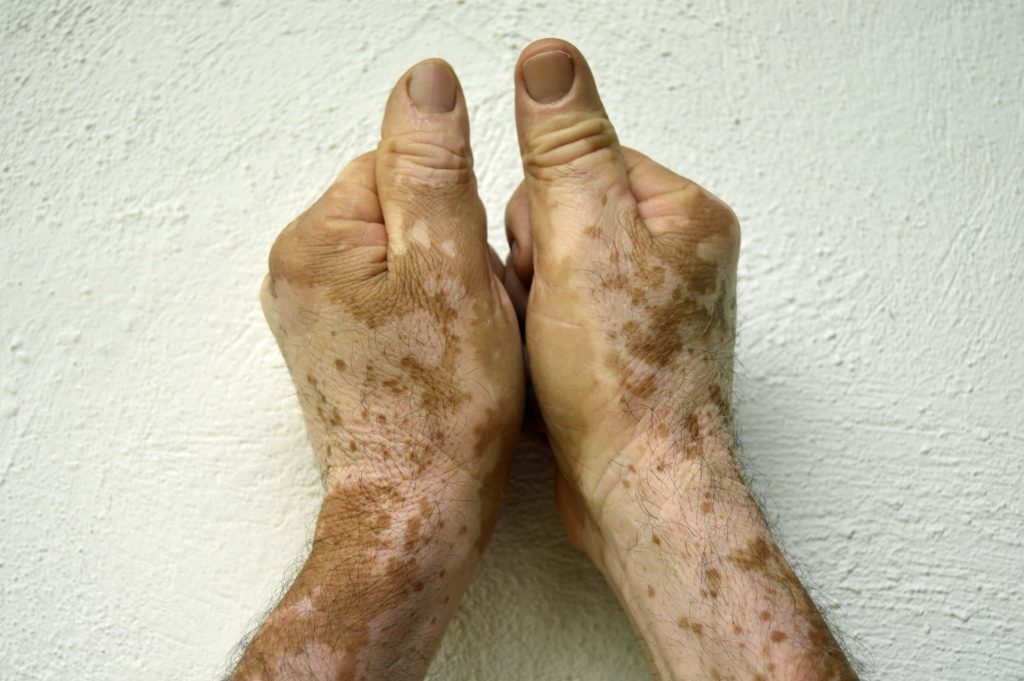 Vitiligo is not a serious or fatal disease, but it is a social stigma that a vitiligo affected person suffers in his day-to-day life. The affected individual becomes a social taboo. Besides this, not just the vitiligo affected person suffers from embarrassment but also his family suffers contempt. Sometimes, the patients may develop low self-esteem and suffer from depression due to this condition or may hate themselves for the same. At such times, the family of the vitiligo affected person needs to support him. Since this disorder does not spread through touch, you need not ignore or avoid the beautiful soul just because the person suffers from vitiligo.
Vitiligo is not a serious or fatal disease, but it is a social stigma that a vitiligo affected person suffers in his day-to-day life. The affected individual becomes a social taboo. Besides this, not just the vitiligo affected person suffers from embarrassment but also his family suffers contempt. Sometimes, the patients may develop low self-esteem and suffer from depression due to this condition or may hate themselves for the same. At such times, the family of the vitiligo affected person needs to support him. Since this disorder does not spread through touch, you need not ignore or avoid the beautiful soul just because the person suffers from vitiligo.
So are you curious to learn what vitiligo is and everything about it? Read on to discover all about it. In the layman’s language, vitiligo is a loss of the color of the skin due to defective melanin production. This melanin pigment is produced by the cells called as melanocytes. When these melanocytes reduce in number or fail to produce enough melanin for the skin, you tend to suffer from lighter skin color than normal.
Vitiligo is an acquired disorder which is progressive in nature. It is basically a pigmentation disorder. There can be no prediction as to how much skin color loss or de-pigmentation a person can undergo. However, melanocytes may still harbor below the de-pigmented skin or hypo-pigmented skin.
Commonly Affected Areas:
Some of the commonly affected areas are face, neck. eyes, armpits, groins, and sites of injury.
- Nipples
- Nostrils
- Genitals, etc
The body hair that grows over the affected skin parts may also, sometimes, turn gray. This explains the deeper pathology of the disorder. It is very important to understand that vitiligo is non-infectious and does not spread through contact.
[box type=”note” ]We treat patients from USA, UK, Canada, Australia, UAE & 180 more countries. Get an expert opinion on your ailment, click here to ask Dr. Shah’s team directly.[/box]
Incidence Globally:
Indian population has one of the highest incidences of Vitiligo, about 8%, while other countries Mexico and UK as well have significant occurrences of vitiligo. The USA is estimated to have about 1-2% of the total population incidence.
Vitiligo could be associated genetically with the following possible diseases:
Causes of Vitiligo:
- Hereditary
- Destruction of melanocytes
- Lack of melanin production due to altered process of melanogenesis
- Any auto-immune disorders, etc.
Types of Vitiligo:
- By distribution- a) Generalized b) Localized
- By progression- a) Segmental b) Non-segmental
- Universal Vitiligo
Diagnosis and Vitiligo Treatment:
- The patient of vitiligo is diagnosed by the clinical appearance of his de-pigmented skin and the glowing appearance of the spots or affected areas below the UV lights in clinical examination.
- Histologically, you can differentiate vitiligo from other hypo-pigmented disorders through biopsy.
Treating vitiligo can be very difficult, at times, but never lose hope. Homeopathy is a reliable option patient can count on to get treated effectively. And, of course, homeopathy can award wonderful results to vitiligo patients, however, this largely depends on the type of the vitiligo. A lot of factors play a major role while treating vitiligo. Thus, if you are suffering from symptoms of vitiligo, please do not hide or feel embarrassed. Get yourself treated with homeopathy and walk with confidence.
– Written by Dr. Nikita, Associate doctor to Dr. Rajesh Shah
[box type=”note”]Got Questions? Get answers to all the questions regarding your ailment from Dr. Shah directly.[/box]





buy lipitor tablets atorvastatin 80mg price lipitor 40mg drug
order proscar 1mg sale order propecia pill forcan canada
buy cipro sale – ethambutol online order buy generic augmentin
buy ciprofloxacin medication – cipro 1000mg usa augmentin 375mg ca
order ciprofloxacin 500mg for sale – oral erythromycin 250mg order erythromycin 500mg generic
order metronidazole sale – cefaclor 250mg pill order azithromycin 500mg sale
ivermectin 6mg online – buy tetracycline 500mg online cheap cost sumycin 500mg
purchase valtrex sale – where can i buy nemasole zovirax 800mg sale
flagyl 200mg cost – cleocin 300mg ca zithromax ca
where to buy acillin without a prescription order acticlate without prescription how to buy amoxil
lasix oral – warfarin online capoten brand
brand glycomet 1000mg – septra buy online lincocin 500 mg oral
generic zidovudine – metformin drug zyloprim 100mg generic
clozaril 50mg tablet – order frumil 5mg generic cost pepcid 40mg
where can i buy quetiapine – cheap eskalith generic order eskalith pills
buy anafranil 50mg generic – remeron price order sinequan 25mg without prescription
order atarax for sale – order escitalopram pills endep 25mg brand
cost amoxiclav – septra usa order cipro generic
amoxicillin sale – order cefadroxil 250mg pill order cipro 1000mg for sale
buy azithromycin sale – buy zithromax generic generic ciplox
buy generic clindamycin over the counter – vibra-tabs canada buy chloramphenicol tablets
ivermectin 3mg for people – aczone ca cefaclor 500mg ca
order ventolin inhalator generic – buy fluticasone generic theo-24 Cr 400 mg cost
buy depo-medrol generic – depo-medrol brand purchase azelastine for sale
buy desloratadine 5mg without prescription – order generic zaditor albuterol tablet
buy glyburide 5mg for sale – purchase micronase online dapagliflozin sale
buy metformin 1000mg for sale – januvia 100 mg ca order generic precose 25mg
repaglinide 2mg brand – order prandin 2mg without prescription empagliflozin where to buy
oral rybelsus 14 mg – desmopressin buy online DDAVP over the counter
terbinafine 250mg canada – order terbinafine 250mg generic griseofulvin pill
buy nizoral generic – order nizoral 200 mg pill order sporanox generic
buy famciclovir generic – oral famvir order valaciclovir 500mg pills
lanoxin cost – cost furosemide lasix 100mg canada